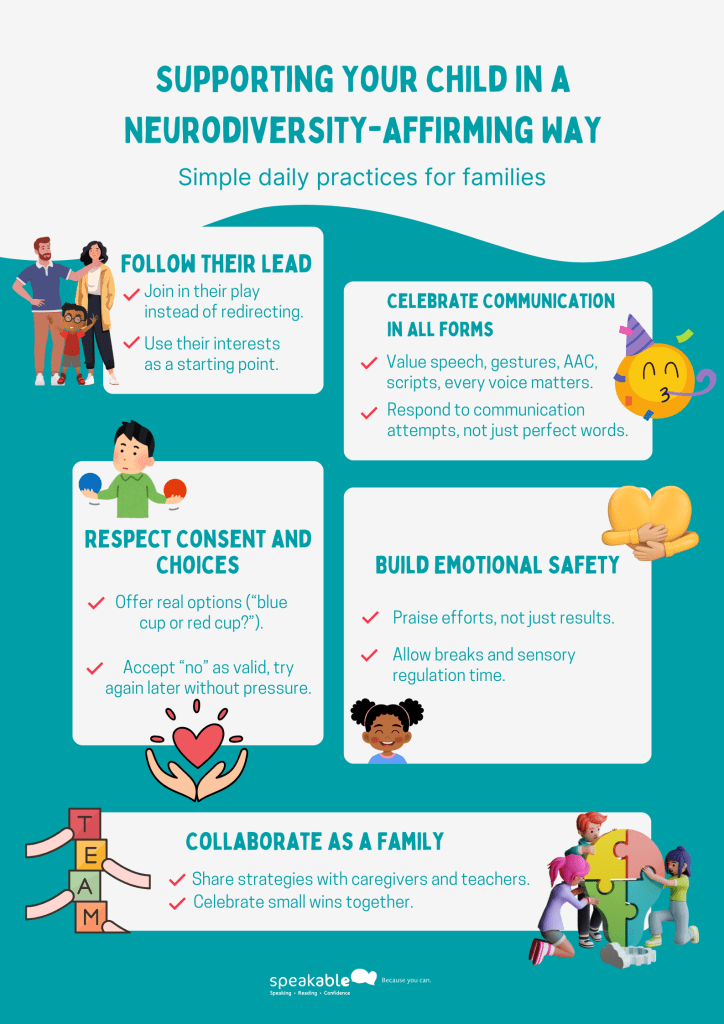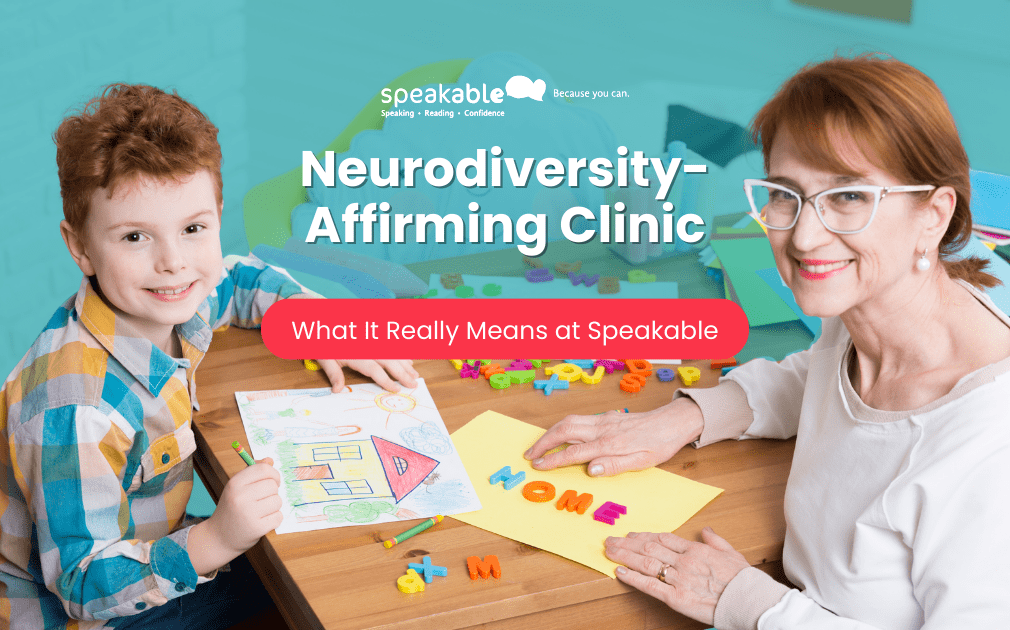What It Really Means to Be a Neurodiversity-Affirming Clinic
Beyond Buzzwords
In recent years, the phrase “neurodiversity-affirming” has gained traction in conversations around autism, ADHD, communication differences, and child development. The term appears in social media posts, professional bios, and clinic marketing materials. Yet for many families, the meaning behind it remains vague. Is it simply a new trend in therapy? A label for progressive approaches? Or does it reflect something more substantial?
At Speakable, neurodiversity-affirming is not a buzzword. It is a daily practice, a philosophy that guides every interaction, every assessment, and every therapy session. This approach reshapes the way children, parents, and therapists work together. It ensures that children are not asked to “fit in” but are empowered to thrive as they are.
What Does “Neurodiversity-Affirming” Really Mean?
The term neurodiversity was first popularized by sociologist Judy Singer in the late 1990s. It describes the natural variation in human neurology, acknowledging that brains develop and function in diverse ways. Autism, ADHD, dyslexia, dyspraxia, and other differences are not deficits to be “fixed” but unique ways of experiencing the world.
Being neurodiversity-affirming means recognizing this truth and applying it in therapy. Rather than trying to eliminate traits such as echolalia, stimming, or alternative communication methods, an affirming approach validates them. Therapy becomes less about compliance and more about empowerment.
The principles behind affirming practice are supported by growing evidence from organizations such as the American Speech-Language-Hearing Association (ASHA), which highlights the importance of individualized, family-centered care.
Core principles include:
- Respect for differences, rather than attempts to “normalize” a child.
- Building on strengths instead of focusing solely on challenges.
- Supporting autonomy, choice, and self-advocacy.
- Creating safe, inclusive spaces where children feel seen and valued.
Why It Matters for Families and Children
For families, a neurodiversity-affirming approach can be transformative. Parents often arrive at therapy with mixed emotions, concern about their child’s struggles, but also a desire to see them celebrated for who they are. Affirming therapy provides both: it addresses communication needs while affirming the child’s identity.
Children benefit in measurable ways:
- Emotional safety: Therapy sessions become spaces free of judgment, where children know they are accepted.
- Stronger self-esteem: When children are recognized for their strengths, they learn to view themselves positively.
- Better long-term outcomes: Research shows that affirming environments reduce anxiety, improve resilience, and foster genuine progress.
The World Health Organization (WHO) also emphasizes that inclusive approaches to child development improve long-term well-being and reduce inequalities in access to care.
Many parents also ask how affirming therapy relates to late talkers. While traditional approaches often focus narrowly on milestones and delays, we emphasize communication in all its forms, building confidence without pressure. Read more about how we support late talkers.
By choosing an affirming clinic, families ensure that therapy supports not just skill development, but overall well-being.
Speakable’s Core Values as a Neurodiversity-Affirming Clinic
At Speakable, our methods are grounded in values that place children and families at the center of everything we do.
Strengths-Based Approach
We begin with what children already do well, whether it’s their creativity, memory for details, or ability to express themselves through gestures or AAC (Augmentative and Alternative Communication). Building on strengths helps children feel capable and motivated.
Child-Led and Consent-Driven Practice
We believe therapy works best when children are active participants, not passive recipients. Sessions are collaborative: therapists follow the child’s lead, respect when they say “no,” and seek consent for activities. Even small choices, like picking a toy or deciding the order of tasks, empower children to take ownership of their growth.
Respect for Individual Preferences and Communication Styles
Every child communicates differently. Some use speech, others AAC, gestures, or scripts. We honor all forms of communication and never treat one as “less than.” Respecting preferences also means adapting sessions to sensory needs, pacing, and environments that feel safe.
For example, many autistic individuals may mask their communication differences in school or social settings, appearing to cope while experiencing significant stress internally. Our affirming practice acknowledges these realities and works to create safe spaces where children don’t feel pressured to hide who they are. Read more in our blog Unmasking Autism: A Practical Guide for Parents and Educators.
Family Collaboration
Parents and caregivers are essential partners in therapy. We share strategies, listen to concerns, and co-create goals. Families leave sessions with tools they can use at home, making progress sustainable and meaningful.
Continuous Learning and Advocacy
Neurodiversity-affirming practice is not static. Our team engages in ongoing training, stays informed about the latest research, and advocates for systemic change. By supporting neurodiversity in schools, communities, and policy discussions, we aim to create a more inclusive world beyond our clinic walls.
How Speakable Puts These Values into Practice
Values only matter when they are put into practice. At Speakable, our philosophy comes to life in everyday sessions and interactions with children and families:
- Play-based sessions: Children learn best through play. We design activities around their interests, whether it’s building blocks, storytelling, or music, so therapy feels natural and engaging.
- Flexible environments: Sessions can happen on the floor, at a table, or even outdoors. What matters most is that children feel comfortable and safe.
- Visual and sensory supports: From visual schedules to sensory-friendly tools, we create spaces that reduce stress and increase participation.
- Incorporation of AAC: We normalize the use of AAC devices, visuals, and other communication supports, ensuring every child knows their voice, whatever form it takes, s valued.
- Celebrating progress, not perfection: Success is measured by confidence, joy, and connection, not just by standardized benchmarks.
This approach also extends beyond therapy sessions into daily life. For example, families preparing children for major transitions, such as starting school, benefit from strategies that respect individuality and reduce pressure. Read more in our blog School Readiness: What It Really Means (Beyond ABCs & 123s)
A Simple Parent Checklist
While values and methods can sometimes feel abstract, families often want practical ideas they can use right away. That’s why we created a simple Parent Checklist with daily practices for supporting communication in a neurodiversity-affirming way.
👉 Here’s a quick visual summary you can save or share:

This checklist offers gentle reminders:
- Follow your child’s lead.
- Celebrate every form of communication.
- Respect consent and choices.
- Build emotional safety.
- Collaborate as a family.
It’s not about doing everything perfectly. It’s about small, consistent actions that make your child feel seen, respected, and empowered every day.
Common Myths About Neurodiversity-Affirming Therapy
Like any evolving approach, affirming therapy is sometimes misunderstood. Let’s address three common myths:
Myth 1: “It means no goals or structure.”
In reality, affirming therapy has clear goals. The difference is that goals are child-centered, functional, and respectful. Instead of aiming to “eliminate stimming,” for example, a goal might be to expand a child’s ability to request what they need in multiple ways.
Myth 2: “It ignores challenges.”
Affirming therapy does not deny challenges. Instead, it addresses them compassionately. We work with children on communication barriers, anxiety triggers, or sensory needs while affirming their identities.
Myth 3: “It’s just a trend.”
Neurodiversity is not a trend, it is a human reality. Affirming therapy is supported by a growing body of research in psychology, speech pathology, and education. Clinics like Speakable are committed to embedding this approach for the long term.
Frequently Asked Questions (FAQ)
What’s the difference between a neurodiversity-affirming clinic and a traditional therapy clinic?
Traditional therapy often emphasizes reducing “deficits” or teaching children to behave in ways that fit typical expectations. An affirming clinic, by contrast, values differences, respects communication diversity, and sets goals that are meaningful for the child and family.
How do parents know if therapy is truly affirming?
Signs include: the child’s preferences are respected, consent is prioritized, and multiple forms of communication are supported. Parents should feel that their voices are heard and that their child’s unique identity is celebrated.
Can affirming therapy still address speech and language goals?
Absolutely. Affirming therapy builds communication skills in ways that are motivating and respectful. Children often make greater progress because they feel safe, engaged, and understood.
Conclusion: Helping Children Thrive, Their Way
Every child deserves therapy that honors who they are. A neurodiversity-affirming clinic is not about fixing differences but nurturing strengths, supporting growth, and building confidence.
At Speakable, our mission is simple: to help children thrive, their way.
Call to Action:




